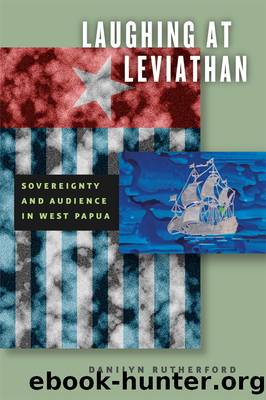Laughing at Leviathan by Danilyn Rutherford

Author:Danilyn Rutherford [Rutherford, Danilyn]
Language: eng
Format: epub
Tags: History, Asia, Southeast Asia, Social Science, General, Anthropology, Cultural & Social
ISBN: 9780226731971
Google: DDLwVU8zOncC
Publisher: University of Chicago Press
Published: 2012-04-15T03:59:48+00:00
On the maps we can read the name of our land, New Guinea, or âNew Guineaâ [Noefoorsch: Guinea Babo]. The Portuguese and Spanish were the first white people to come to the land of Papua, and when they saw the people in the land, they said, âThey look just like the people of Guinea, Africa!â So they called the land New Guinea. (1900, 4)
Because ânot all of New Guinea obeys the Young Queen of Holland (Nonna Radja Wolanda),â the narrator will just treat the western half.
The Papuan people donât have just one tradition or set of customs (adat). In one place things are a bit good, in another place they are more evil, in one place they plunder a lot, in another place they do not fight with one another. . . . I wonât tell you about the customs or houses of the Noefoor, because you already know much more about that than I do. (Ibid., 5)
Instead, the narrator takes his readers to Humboldt Bay, named âout of respect (hormat) for Mr. (Toean) van Humboldt, a German gentleman who saw many lands and peoplesâ (ibid., 5). Humboldt Bayâs inhabitants âwalk around totally nakedâ and worship idols (korwaar). âAlas! They donât yet know what we read in Psalms 127:1: âIf the Lord doesnât guard (djaga) a house, men guard it in vain. They ask wooden [Gods/figures] to guard their houses, but wood doesnât see, doesnât hear; safe (slamat) are we who know to pray to the Lord Godâ (ibid., 6). The narrator proceeds to the west coast of New Guinea, then Ternate and Tidore, whose inhabitants, we learn, rejected the Spanish and Portuguese, but welcomed the Dutch peopleâs offer to help (betoelong) their rulers in wars. The tour continues in a similar vein through the eastern part of the colony, before finally reaching Java, âa really nice island,â where the text dwells for a disproportionate amount of time.
The ship drops anchor at the port of Tandjoeng Priok, in Batavia, the Indiesâ capital. The narrator describes Bataviaâs âmany villagesâ (mennoe naboor) (ibid., 49). There is much to see in Batavia: the Governor Generalâs house, âa big person made of copperâ (a statue of Jan Pieterzoon Coen, Bataviaâs seventeenth-century founder), âmen and women wearing all sorts of clothing (bepaké sansoen roepa-roepa) (ibid., 49). âIf we are tired and the road is long, we call for a carriage, many of which weâve seen in Batavia, and we pay some money and it takes us where we want to goââ (ibid., 49â50).
The tour next takes us to Depok, the school founded by a minister who âthought it would be good if black people were taught by black men helping the Dutch missionariesâ (ibid., 50). We witness a geography lesson and watch the students playing their musical instrumentsââsoon we are deafened by the great noiseâ (ibid., 51). Leaving Depok, we pass through tea plantations, visit the âvery niceâ village of Bandung (a major city in West Java), and take a trip up the famous volcano, Tankoban Prahoe.
Download
This site does not store any files on its server. We only index and link to content provided by other sites. Please contact the content providers to delete copyright contents if any and email us, we'll remove relevant links or contents immediately.
The Sympathizer by Viet Thanh Nguyen(4305)
The Rape of Nanking by Iris Chang(4137)
World without end by Ken Follett(3428)
Ants Among Elephants by Sujatha Gidla(3417)
Blood and Sand by Alex Von Tunzelmann(3138)
Japanese Design by Patricia J. Graham(3109)
City of Djinns: a year in Delhi by William Dalrymple(2514)
The Queen of Nothing by Holly Black(2492)
Foreign Devils on the Silk Road: The Search for the Lost Treasures of Central Asia by Peter Hopkirk(2434)
India's Ancient Past by R.S. Sharma(2416)
Inglorious Empire by Shashi Tharoor(2395)
Tokyo by Rob Goss(2389)
In Order to Live: A North Korean Girl's Journey to Freedom by Yeonmi Park(2345)
India's biggest cover-up by Dhar Anuj(2318)
Tokyo Geek's Guide: Manga, Anime, Gaming, Cosplay, Toys, Idols & More - The Ultimate Guide to Japan's Otaku Culture by Simone Gianni(2314)
The Great Game: On Secret Service in High Asia by Peter Hopkirk(2305)
Goodbye Madame Butterfly(2203)
Batik by Rudolf Smend(2124)
Living Silence in Burma by Christina Fink(2038)
